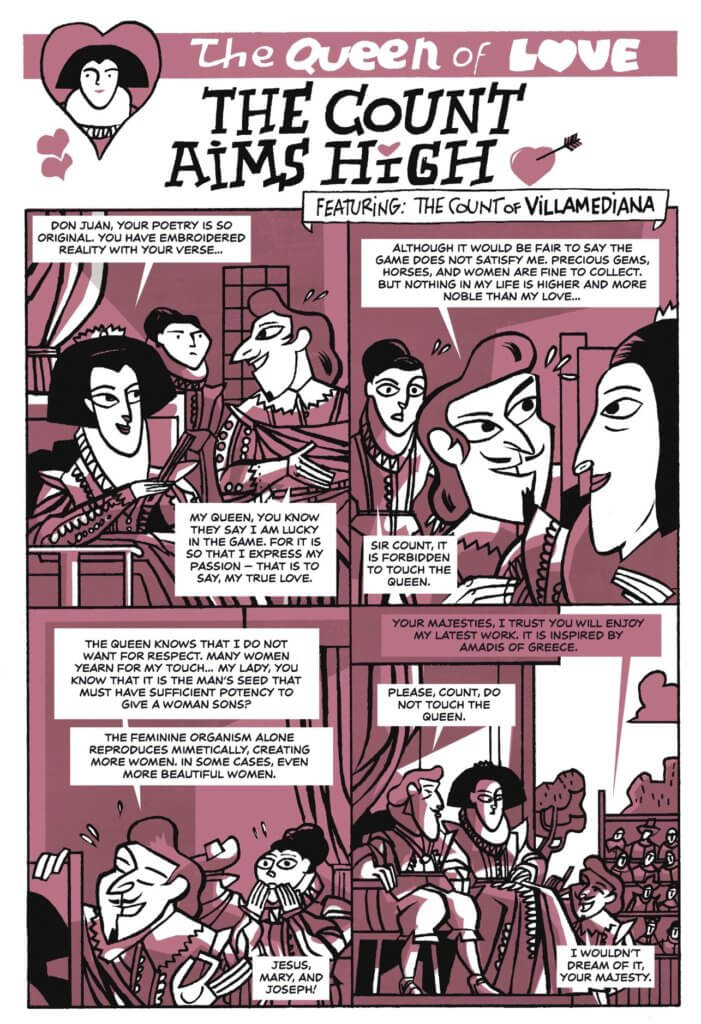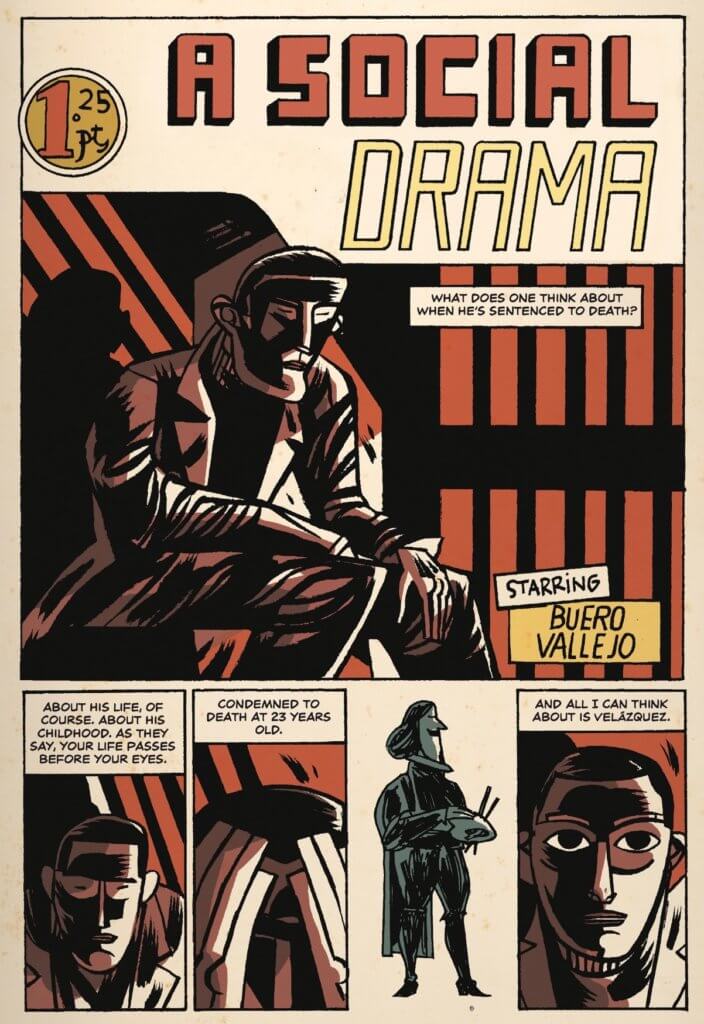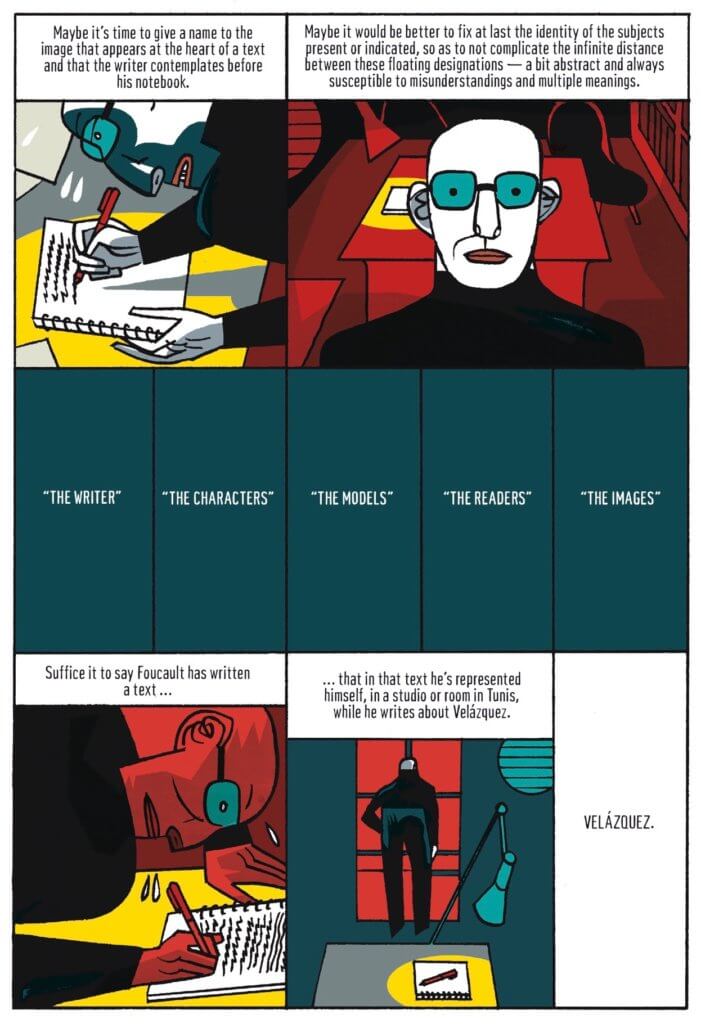As a Spanish professor with an affinity for comics and graphic novels, I am known to make time to peruse the comic book stores whenever I get to Spain. But I also have a special affinity for the great masters of art, and so I also make sure I have time to visit El Prado museum so that I can see my favorite pieces of art by El Greco, Diego Velázquez, and Francisco de Goya y Lucientes. So, one can only imagine my delight upon entering Madrid Comics and stumbling upon Las meninas, a docu-drama graphic novel by Santiago García and Javier Olivares which is the title of Diego Velázquez’s masterpiece. The English translation of the work, Ladies-in-Waiting, was published by Fantagraphics in October of 2017.
I call this comic a “docu-drama,” rather than historical fiction because like most creators of fiction set in the past, the creators heavily researched Velázquez’s life in order to accurately portray the major events that led up to the painting of Velázquez’s masterpiece. The part that is a little different is that they included the sources they used for research, like one would with a documentary or other heavily researched non-fiction project, in the backmatter. And while they have included key historical events, they also make sure to note at the end that the comic is a word of fiction; such a disclaimer is another generic move more like one would find at the end of a film rather than is typically found in historical fiction.
The comic separates the story into five main sections (plus a brief prologue) with titles: The Key, The Mirror, The Painter’s Painter, The Cross, and The Theology of Painting. Each section narrates a certain aspect of Velázquez’s life, leading up to the painting of his masterpiece. Within each section are smaller stories as well, each with its own artistic aesthetic, and some lasting only a single page.
Many of the stories that García and Olivares show us are intended to demonstrate the importance of Velázquez’s mentors and the impact they had on his life—including a fascinating anecdote about one of his mentors, Alonso Cano, who was accused of the murder of his wife, fled Madrid, was captured and tortured, but due to his favor with the King was eventually found innocent.
Velázquez found great favor among many artists, as is shown in the comic. He studied under Francisco Pacheco, whose daughter, Juana, he ended up marrying. Through him, he is introduced to King Felipe IV, and eventually is tasked with filling the palace with artwork and becoming the royal painter. This is all shown in the comic. Velázquez is shown making his two trips to Italy to find art to fill the palace where he meets other artists and … having a Roman child by an unknown mother. Through their investigation, it is believed that the mother of the child is Flaminia Triva. She was a Roman model who posed nude for his “La Venus del espejo” and was also a painter who did a portrait of him.
But that is most interesting about this whole comic, named for his masterpiece, “Las meninas,” is that only about one-fifth of the comic’s content is actually based on his painting of the piece of art and the aftermath. It makes the reader wonder what the creators wanted to achieve by focusing so much on these other stories, many of which, while told from the perspective of important artists like Picasso and Dalí, and Spanish writer Buero Vallejo, make references to Velázquez’s masterpiece before the reader ever sees it for themselves. It is only in the last forty pages of the comic that we actually see the painting being worked on, finished, and what happened after, when there was a fire in the Alcázar where it was being kept. It is a fascinating section.
Throughout the comic, there have been references to mirrors, and for anyone who has seen the painting knows that mirrors are a huge part of the painting both within and out of it. The artist is either looking out at the spectator or is looking at mirror to paint the scene that is within the painting. At the back of the painting, to the right of the artist’s shoulder, is a mirror which portrays the king and the queen. García and Olivares not only focus on Velázquez’s fascination with mirrors, which are found in several works, but they also open the first chapter, “The Key,” with panels featuring French philosopher Michel Foucault and his writings about art and mirrors—another generic move that distinguishes this comic from its historical fiction contemporaries. The comic is part history, part story—and part critique.
I must admit, if it weren’t for the ingenuity of García and Olivares, the constant jumping back and forth in time would have been confusing. However, they found a way to keep the reader aware of when they are in a different time period. Each “story” has not only its own color palette, but in some instances, stylistic variations as well. We start in Madrid, Spain, 1665—but that’s far from the only time and place the creators take us on this journey. When we jump forward to see Pablo Picasso, Salvador Dalí, the style changes, subtly referencing the modernist aesthetic of the respective artists. Each time period has its own unique aesthetic that allows the reader to follow the temporal jumps without needing to be reminded of which century the story is taking place in.
Even though I started off by saying that I was drawn in by my love for Velázquez and Spanish comics, what impressed me most is that you don’t need to have a love of history or art to find this comic enthralling. García and Olivares take a story about an artist and his desire to create a masterpiece and have made it captivating. Even if you know nothing about art, history, or Spanish comics, the comic itself acts as a gateway to all three. While I could use it in one of my Spanish courses alongside any textbook, the comic itself teaches so much more than just the history.





